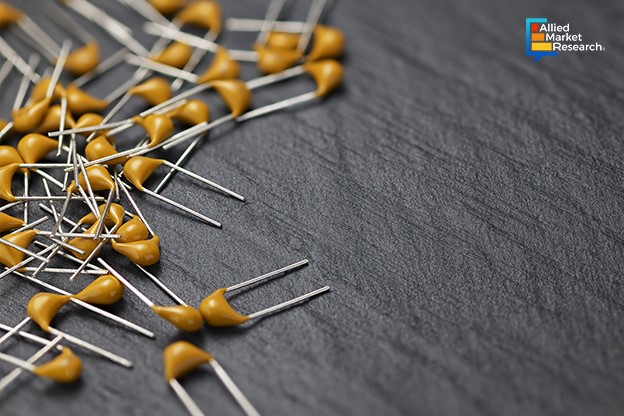How Has IoT Revolutionized the Ceramic Capacitors Industry?

27 Feb
2025
Key Takeaways:
- Introduction
- Increasing applicability of ceramic capacitors
- Innovative product launches in the industry
A ceramic capacitor is a passive electronic instrument used to store and release electrical energy in a circuit or an electric field. The unique thing about this capacitor is that the function of a dielectric is performed by a ceramic or a porcelain material which exists in a non-polarized form. Typically, carbide or nitride compounds are used to manufacture these specialized capacitors that are used widely across different end-use industries, including automotive manufacturing, consumer electronics, and telecommunications.
The increasing popularity of ceramic capacitors impacting the industry positively
In the last few years, the utility of ceramic capacitors has increased significantly, mainly due to their certain unique characteristics. The size of these capacitors is relatively small compared to other electronic components which makes it ideal for modern smart gadgets and portable devices such as wearables, smartphones, laptops, etc. The advancements in the automotive manufacturing industry, including the advent of advanced driver-assistance systems, have increased the use of these components drastically.
Ceramic capacitors mainly come in class 1 and class 2 application types which are designed specifically to perform a diverse set of applications. Class 1 semiconductors are used in circuits in which high stability and low losses are preferred, while class 2 variants are deployed for less sensitive ICs. The ability of these capacitors to withstand voltages up to 100 V makes them perfect for high-density power appliances and DC motors. In recent times, the growing use of IoT devices has increased the popularity of class 1 ceramic capacitors. These components work well in different temperatures, making them ideal for decoupling, electronic oscillators, and electrical filters.
Furthermore, companies have started developing multilayer ceramic capacitors which have created new investment opportunities in the industry. These energy storage components offer higher capacitance in the same volume, thus enhancing their performance in hybrid integrated circuits. The gradual shift toward miniaturization of ICs has played an important role in expanding the scope of ceramic capacitors.
Innovative product launches opening new avenues for growth
The growing investments in R&D activities for designing advanced Multilayer Ceramic Capacitors (MLCCs) are expected to help the ceramic capacitor industry flourish in the coming period. Many leading businesses have launched advanced components to cater to the evolving demands of the semiconductor fabrication sector. For example, in March 2024, TDK Global, a Japan-based multinational electronics production company based in Japan, announced the expansion of its product portfolio by unveiling a new series of MLCCs. The company has claimed that this new CGA series offers the industry’s highest capacitance in automotive applications.
Similarly, in July 2024, Samsung Electro-Mechanics, a South Korean electrical company, announced the launch of a new multilayer ceramic capacitor, viz., CL32B226KLV6PN#. Designed for 48 V/12 V bidirectional DC-DC converter output stages, this high-tech MLCC has been developed using ultra-precision stacking techniques. The 1210-inch size and high capacitance offered by the product make it ideal for 12 EV battery systems. The MLCC, thus, aims to address the demands of the modern automobile manufacturing sector and helps automakers develop state-of-the-art electric mobility solutions.
On the other hand, in September 2024, Murata Manufacturing Co., Ltd., another Japan-based electronics firm, announced the launch of the world’s smallest MLCC with 006003-inch size. The press statement issued by the enterprise highlights that the product has been developed to cater to the growing trend of miniaturization and sophistication of electronic devices. With a volume ratio of 75% to the current smallest MLCC, the capacitor is now being used widely in the production of smartphones and wearable gadgets. Hidetoshi Nakagawa, General Manager of the ceramic capacitor department at Murata Manufacturing Co., Ltd., stated that the product launch demonstrates the company’s focus on R&D in cutting-edge technologies to improve the quality of modern electronic devices.
Winding up, the growth of the ceramic capacitor industry is attributed to the rising demand for these advanced components from the consumer electronics and automotive manufacturing sectors. Moreover, the emergence of IoT and the transition toward miniaturization of smart devices has contributed to the expansion of the market. In addition, the launch of innovative products by multinational giants is anticipated to boost the revenue of the landscape in the coming period.
For more information on the leading growth drivers and investment opportunities in the market, contact our experts here!

Akhilesh Prabhugaonkar
Author's Bio- Akhilesh Prabhugaonkar holds a bachelor’s degree in Electronics Engineering from the reputed Vishwakarma Institute of Technology. He has a special interest in the fields of forensics, world history, international relations and foreign policy, sports, agriculture, astronomy, security, and oceanography. An ardent bibliophile and melophile, Akhilesh loves to write on topics of his interest and various other societal issues. This love for writing made him enter the professional world of content writing and pursue his career in this direction.
Smart Electricity Meters: A Futuristic Solution to Ensure Sustainability and Energy-Efficiency
Avenue: Entire Library membership of Allied Market Research Reports at your disposal
- Avenue is an innovative subscription-based online report database.
- Avail an online access to the entire library of syndicated reports on more than 2,000 niche industries and company profiles on more than 12,000 firms across 11 domains.
- A cost-effective model tailored for entrepreneurs, investors, and students & researchers at universities.
- Request customizations, suggest new reports, and avail analyst support as per your requirements.
- Get an access to the library of reports at any time from any device and anywhere.
Related Post
-
How are Submarine Cables Transforming Global Connectivity with Enhanced User Experience?
-
Endoscopy Procedures: Transformations in Techniques and Applications
-
AI-Powered Video Analytics: How the Product Actually Works for enterprises
-
Painting Robots: Transforming Precision Coating and Creative Applications
-
Innovations in Pharmacovigilance Systems Advancing Patient Safety
-
Understanding Edge Security: Keeping Data Safe Near the Source
-
Exploring the Use and Advancements of 3D Laser Scanners in Professional Applications
-
Reinforcing Industrial Controls with Smarter Tools and Training








